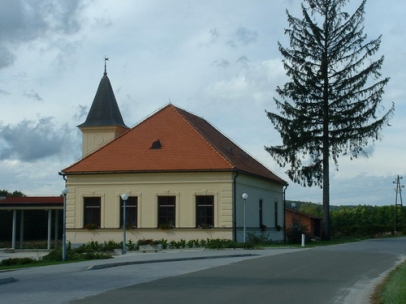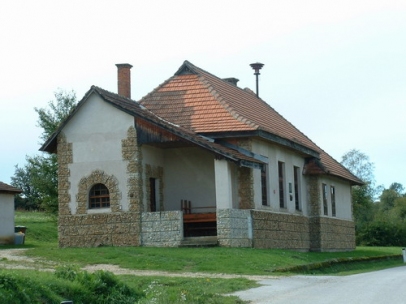Dvorci, vile in stare šole
Vila Vogler na Cankovi
Vila Vogler oz. bivša gostilna Vogler se nahaja na trgu sredi gručaste vasi Cankova. Mogočna gostilna je enonadstropna vogalna hiša, ki s pripadajočimi gospodarskimi poslopji tvori zaključeno celoto. Fasada je poenostavljena, okna v pritličju so brez obrob, v nadstropju imajo profilirane karnize in police. Na oknih v nadstropju so nastavki za polkna. Na severo-zahodnem vogalu je lep kovan izvesek. Dvoriščno fasado v nadstropnem delu krasi lesen gank s struženimi stebrišči. V notranjosti so pritlični prostori nekdanje gostilne obokani. Vzdolž vzhodnega roba dvorišča stoji zidano pritlično gospodarsko poslopje, kjer so bili konjski in svinjski hlevi. V slednjem so se ohranili stari leseni boksi, saj je bil gostilničar Vogler velik trgovec s svinjami. Temu nizu hlevov sledi zidani nadstropni skedenj v L. Ob cesti v vzhodnem delu dvorišča stoji delno leseno delno zidano pritlično poslopje, ki se je najbrž rabilo za shranjevanje raznega orodja. Sredi dvorišča stoji zidana nadstrešnica za vozove, saj je bila gostilna postaja za furmane. Gostilna Vogler s pripadajočimi gospodarskimi poslopji velja za dobro ohranjen primer stavbne dediščine, ki se je na svojstven način vključevala v gospodarsko, socialno in kulturno življenje v tem prostoru ob slovensko-avstrijski meji. Kot taka je pomembna tako z arhitekturnega kot etnološkega in socialno-zgodovinskega vidika. Danes je v Vili Vogler urejena Kavarna in turistično-informacijska točka. Več o kulturni dediščini v kraju Cankova najdete tukaj.
Ostanki dvorca Matzenau
Na skrajnem vzhodu Prekmurja, tik ob Madžarski meji, ždi dvorec Matzenau, ki so ga v začetku 19. stoletja pozidali grofje Batthyany. Leta 1900 ga je kupil avstrijski konzul, po rodu Čeh, grof Matzenauer. Služboval je v Peruju in Vatikanu, kjer mu je papež podelil plemiški naslov. Dvorec je opremil z odličnimi primerki stilnega pohištva, militarijami, slikami in eksotičnimi predmeti iz raznih krajev sveta. Usoda teh stvari danes ni znana. Sama zgradba je bila zgrajena v razkošnem, neoklasicističnem slogu. Zanimiv je na treh arkadnih lokih počivajoč altan, ki ga v zgornjem delu poudarja dvojni grb rodovine Matzenauer. Vsebino dvorca dopolnjuje danes že zaraščen park, z nasadi bukev, smrek, platan in drugih tujerodnih dreves. Nekdanja parterna ureditev parka je vidna v tlorisu starega katastrskega načrta. Ostanki obrob poti in osrednjega vodnega motiva so zakriti z zemljo in listjem.
O preteklosti dvorca sta znani dve priliki. Manj verjetnejša je tista o Napoleonu, ki naj bi v dvorcu prespal. Lastnikom naj bi v spomin podaril laterno. Druga pravi, da je bila v dvorcu po 1. svetovni vojni podpisana pogodba o mejni črti med Madžarsko in Prekmurjem. Prvi kataster za to območje je bil izdelan 1866. Znano je tudi, da se je med leti 1866 in 1900 menjalo sedem lastnikov (Olga Wrede, Jožef Wrede, Vilmos Boschan in njegova žena, Jožef Lenner, banka iz Budimpešte, Henrik, Vilmos in Gyula Pick, Ferenc Egger, Denes Craigher. Nato ga je odkupil Carl von Matzenauer, ki je v dvorcu ostal do smrti. Viri: F. Kuzmič: Ruševina v Prosenjakovcih. Vestnik, 1 .8. 1985, F. Štefanec: Gradovi na slovenskem severovzhodu. Prosenjakovski dvorec. Vestnik, 7. 5. 1998.
Danes je dvorec v ruševinah in ni primeren za obiskovanje.
Szaparyjev dvorec, Marof v Mačkovcih
Dvorec naj bi zgradili leta 1905. Ime marof izhaja iz nemške besede Meierhof in pomeni posestvo ali kmečko gospodarstvo, ki so ga lastniki dajali v najem upravitelju, majerju. Danes je obnovljena stavba dela kompleksa vinske kleti in gostišča, znanega poznavalcem dobrega vina in kulinaričnih dobrot.
Stare šole
Šole, ki so nastajale v prvi polovici 19. stoletja, je gradil industrialec Geza Hartner iz Murske Sobote. Še danes so prepoznavni arhitekturni element na Goričkem. Prepoznamo jih po enotnem videzu. Najdemo jih v Stanjevcih, Gerlnicih, Šulincih, Andrijancih, Brezovcih in Markovcih.
Šola v Šulincih s talnim zidcem in stenskim robom iz 1913. Obsega učilnico in učiteljevo stanovanje, zraven je pomožni objekt. Sezidati jo je dal industrialec Geza Hartner po vzoru šole v Adrijancih. Pouk je bil ukinjen 1962, danes ima funkcijo vaškega doma.
Datacija: prva četrtina 20. stol. Več o šolah...
Stara šola v Stanjevcih je prenovljena in služi kot kulturni dom.










